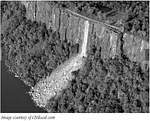Palisades Rockslide
I heard and felt nothing that I can remember at home where Washington Spring Road begins its descent on the precipice of the cliff, when a shaft of approximately 10,000 tons of Palisades diabase broke free from the rock face of the Hudson Palisades at the Alpine State Lookout, only a mile and a half away. Collapsing in a cloud of dust and boulders onto the scramble called the Giant Stairs edging the river below, it occurred at 7:28 pm on May 12, as peaceful an evening as any other.
The event registered on the seismometer at Lamont-Doherty Earth Observatory. During those 35 seconds, the falling rock, some fragments the size of a building, obliterated everything in its path, including a mature stand of oak, black birch and paulownia, as well as anything living in and around them. River mud and mollusks were heaved up on shore. No humans were injured, but it still gives one pause.
Christina Fehre, the trail supervisor for the Palisades Interstate Park Commission, said in a New York Times interview that there has not been a rock fall of this magnitude for more than 20 years. But anyone who has scrambled over the Giant Stairs, a heap of boulders at the base of the Palisades also known as the Shore Line Trail, knows that rocks are constantly tumbling down. According to Bill Menke, a seismologist and professor of Earth and Environmental Sciences at Lamont-Doherty, in his online article, Lessons From a Rock Fall, rocks fall every year, with a major fall every decade or so. Gradually, the mound of boulders at the base rises higher, obscuring more and more of the cliffs. He speculates that at one time, the cliffs that now measure 539 feet at the highest point may have been a thousand feet or more high before they were sculpted by the great glaciers creeping down the Hudson Valley 20,000 years ago.
Running from Jersey City to Nyack and Haverstraw, the Palisades were formed in the Triassic Era about 200,000 years ago, during a catastrophic volcanic event in which molten lava was forced through the existing nearly flat sandstone. Eventually, the softer sandstone eroded in the weather, leaving the cracked basalt columns we see today.
Water seeps into the cracks and the freeze/thaw cycle together with the roots of vegetation pull at the columns until one breaks free, revealing yet another fissured column behind it, and the process begins again.
The Palisades have long attracted the awe of visitors and inhabitants alike. The Lena Lenape tribe, indigenous to the Hudson Valley, called the cliffs “rocks that look like rows of trees” and Verrazano described them in the 1500s to the mapmaker Gerardus Mercator as a “fence of stakes.” In 1983, they were designated a National Landmark.
The fresh gash is all but invisible from the State Line Lookout. Freshly exposed rock is just discernable a few feet from the edge of the stone wall that demarcates the line of safety. Aerial views of the rock fall show with unnerving clarity how previous falls have eaten away at this stone wall and how the wall has had to be moved back. One can also see the lookout perched atop a column that must surely, with enough time and weather, abide by the laws of nature and itself plummet to the bottom in a great crashing roar.
The trail to the Giant Stairs is now closed indefinitely, deemed by the Palisades Interstate Park Commission to be highly unstable and dangerous. Repairs will begin using heavy machinery, simple tools and the forces of nature to ensure that the boulders are settled sufficiently for hikers to safely return, hopefully in the spring. Meanwhile, kayaking is the safest way to get a close view of the rock fall and marvel at how the world we live in is still dominated by the after-effects of the Ice Age.
For dazzling aerial photographs of the rock fall, go to: www.newyork.cbslocal.com


